

Jordan Hoyt - NanoJapan 2013
University of Tulsa
Major/s: Mechanical Engineering
Anticipated Graduation: May 2016
NJ Research Lab: Kawata Lab, Osaka University
NJ Research Project Poster:Macro-scale Bubbles for Aligning Carbon Nanotubes
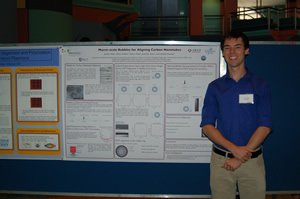
Meaning of NanoJapan - Post-Program
NanoJapan is scientific discovery, world discovery, and self-discovery all in one summer. It gives young undergraduates the chance to experience graduate student life in a state of the art lab on the other side of the world. But more importantly, it gives young college minds the unbridled power to dream. This is a dream that is incredibly achievable. It is the opportunity to be part of something much bigger than an individual both in respect to being involved with a group of like-minded individuals and to contribute to the world of science that transcends cultural and language barriers. It is the chance to reach towards parts of the future that have not yet even been conceived in the most adventurous imaginations. This dream transcends time as well as culture and distance.
Even as my studies resume at the University of Tulsa, I'll have, in the back of my mind, the vision for a future in a cutting edge lab, doing world-changing research, with a family of brilliant individuals from around the world. This is what truly distinguishes the NanoJapan program and it is what NanoJapan means to me.
Why NanoJapan?
Currently, there is a perceived false cost to traveling to a foreign country such as Japan that is so great that it inhibits the free exchange of technical innovation and scientific discovery. With this perceived cost playing such a key role in hindering international ties between scientists, The National Science Foundation has correctly invested its money into strengthening these relationships. NanoJapan has already influenced my own perceived cost to studying abroad and even if I did not garner acceptance into this program I would have been more likely to study abroad in a country far different than my own.
Along with breaking down the false boundaries for international research, NanoJapan allows for the inspiration of the next generation of scientists. Although it is a requirement to present my NanoJapan experience to a group of high school or middle school students, I'll find it incredibly challenging not to present to at least 3 groups, including my home high school, Tulsa University's Physics Journal Club, and Tulsa Technology Center's concurrently enrolled high school students. It is my goal to teach and impassion others through professorship so NanoJapan is the perfect niche for my time. Also, spending the summer in Japan on stipend isn't bad either. Here are some of my goals for the trip!
My goals for this summer are to:
Research Project Overview
This summer I had the once in a lifetime opportunity to do bubble research! For two months at Osaka University I was able to research the affects of macro-scale bubbles on the alignment of carbon-nanotubes. These bubbles ranged in diameter between 5mm and 20mm, which is surprising to some who are expecting Nano scale bubbles. I must admit that I had no idea what to think when my advising professor said he was playing with his kids in his backyard with bubbles and decided it could be an interesting research topic for me. But in retrospect, working with bubbles structures was perfect for my mechanical engineering background, especially just coming off of my statics class at Tulsa University. Being able to say that I spent a summer being a bubble researcher is something special in itself as well. In fact it matches quite well my own personality as well as my engineering experience. I've always seen myself as a relaxed individual who takes his child-like fascination with life and the universe into the lab. Especially since my name means "joke" in Japanese I knew this was the perfect research topic for my summer. And as I later found out, most of my lab mates shared this same fun-sharing atmosphere with their research life.
Since I had never worked with Carbon Nanotubes before, this researched offered a new experience in research as well as a new experience culturally in a Japanese laboratory. Lab mates came to office around 10-11 typically and sometimes stayed quite late, occasionally the whole night. However this should not be seen as a bad thing! It's easy to see the lab office almost like a 2nd home, a cool community where you never feel like you're working alone. The work is accompanied by companionship. This is one of my favorite things about the lab and is one of the many reasons this summer has made me pretty sure I want to go to grad school. The international setting of the lab also makes an outsider like myself into a valuable resource. At times I was amused to find myself proofreading papers and becoming an English teacher since I was one of the few native English speakers around. Also my more American personality of courageous enthusiasm and boldness is seen as a benefit for labs so, in many ways, just being myself and being American is a big benefit to the lab. The NanoJapan experience has made me more likely to travel the world to places like Europe and to some places I had never even considered before like Malaysia and China. This experience has changed my world view significantly.
Daily Life in Japan
You will likely be stared at for most of your time in public in Japan whether you notice it or not. This is mostly because they are interested in looking at you just as much as you are interested in looking at them. This shouldn't be confused with dislike but sometimes they will associate you with bad things if you live in the international dorm where many guys do rude things. For the most part it can be really fun to be stared at all the time and you should see this as a fun experience. Take pride in going against stereotypes of foreigners in Japan by showing respect for things that they show respect for like not crossing streets at non-cross walks and by not eating too often on the streets. Living in an international dorm can be a very rewarding experience and you should try to add friends you make there on fb in order to have international connections. You will be exposed to the whole world in a place like this so enjoy it and talk to people!
Osaka University's cafeteria is delicious and you should try everything on the menu! Every Thursday a big oven is set up in the commons area on campus and makes delicious pastries. Be warned. There's a library on campus and if you want you can check out the Japanese for Busy People books there with the help of a local. There are a few large grocery stores around the area so buying breakfast from these locations can be a great way to save money during the week. For the most part, going with the flow of your lab mates is the best idea for the best experience in Japan and the most fun.
Favorite Experiences and Tips
Tips for Future NanoJapan Participants: Ride a bike to campus if you can. Japanese bikes are strange sometimes but you'll get used to them. Baskets are also useful on bikes. Also sometimes the front light is powered by the motion of the wheel by a dynamo. When you get to Japan, buy an umbrella. Take good care of this umbrella and I dare you to try to make it last the entire summer. Umbrellas are cheap and cool in Japan so they also make good gifts. The Sanuki club hotel that you'll be staying in at Tokyo sells good ones for about $5 each (hopefully the exchange rate doesn't change this too much). Before leaving on your last day in Japan it's not a bad idea to buy 1 or 2 for people back in the states.
Pre Departure Tips: You're not going to have hardly any free time once you get to Japan. In fact, as soon as you learn that you have been accepted to the NanoJapan program you should start getting ready and preparing so you'll be busy. This means you won't likely have time for any sort of books for pleasure or much of any other projects that take time that aren't related to NanoJapan. Focus on completing the assignments and learning the language and learning about your research project. Also a couple of source told me to get a points card for convenient stores since you'll be using them alot while in Japan. I think you have to wait till in Japan to get one but definitely do research into Tsutaya and Ponta cards. You can save money or something with them. I'm told to get both as soon as you can but I went the whole summer without one so you'll be fine if you don't.
Orientation Program Tips: Tokyo is amazing. Go to every part of Tokyo that you can and use every free evening wisely. Get connected to KIP students as quickly as possibly especially if they email you. The ones who email you are likely the ones that will be joining you for most of the events. Also invite them to nightly outings if you can. They can offer a great perspective on the city and the region that you might not be able to get from your lab mates.
Mid-Program Meeting Tips: Karaoke is a blast for mid-program! Take plenty of pictures! Explore a little. Since my year was the first year in Okinawa we weren't exactly sure what to do during free nights but karaoke, tennis, soccer, and fireworks worked well! This was also an amazing time do sumo wrestling on the soccer field! Being able to say that you did sumo in Japan is amazing! Enjoy the company of the OIST students if they join you. They are cool people.
Working With your Research Lab Tips: Remember to speak slower! This is a big thing that you probably won't be used to if you've only been in America where everyone is used to hearing English. Use fewer idioms/sayings and make your language easier to understand. Also be sure to remember your lab mates' names! There is a board that has all of the names so you should take a picture of this on the first day and learn the names. I can also email you the picture I took last year if you want to get a quick start to recognizing Japanese names (most names should be the same). This can be difficult. Remember that learning Japanese can be a really fun thing to do and slang can be a very valuable tool for making friends! Teach them English slang and try to pick up some Japanese slang as well! Let them show you what is best to buy in the store. Always ask for recommendations for anything really. "osusume wa nan desu ka?" means "what is your recommendation." Also remember that your perspective and brainstorming on your research process is valuable to the group!
Living in your Research Host City: I lived in a super cheap all guys' dorm that had quite a few bugs and gross showers but it was well worth it for the price. You won't have to worry about money that much at all on the trip if you're living in the same place that I was. Some people warned me that bringing a pillow might be a good idea because Japanese pillows are a little different but there was no need to bring a pillow at all and I got stuck carrying around a big pillow for much of the trip. If you want, maybe bringing a smaller pillow that you're comfortable with might be good but for the most part you probably won't have pillow troubles. Just going on a bike ride around town is a great way to get lost in the culture (sometimes literally). If you can find someone else who wants to ride around this can be an amazing experience and bike riding is a great way to get into shape. Many members of NanoJapan lost 20-30 lbs over the summer. (I didn't have too much to lose, however I did lose a somewhat noticeable amount of fat but made up for it by gaining some leg and arm muscle, keeping me at the same weight).
Language Study Tips: In this summer you are completely capable of adding a whole new language to your resume and your life if you so desire. It's an amazing way to connect to people for the rest of your life and if you're like me and never took learning other languages seriously then this is a great opportunity to try it. I wish I had bought all 3 of the Japanese for Busy People books! Instead I was stuck finding random free resources around. Apple apps like Tae Kim's guide to learning Japanese is one of the best apps and http://www.learn-japanese-adventure.com was one of the best websites and both were free! However I quickly became obsessed with the language so I would recommend buying more of the Japanese for Busy People books. Midori is the best app for iphone/ipad but if you don't want to pay the $10 for it then imiwa will be OK. I focused mainly on speaking but learning some Kanji and learning to read is important as well since reading signs in subways sill help you discover how words are used in speech. The Japanese Language classes at Osaka University won't match up well with your knowledge from Tokyo so it's best to self-study and to learn from your lab mates! What tips do you have to share on studying Japanese language? From things to do before you go, ways you can improve or expand on your language skills during the research internship, to available language classes during your research internship period what do you wish you would have done or would have known about studying Japanese either before arrival or during your time in Japan. Warning: even by the end of the summer you may not be able to understand your lab mates when they talk to each other. This is something that only people who are fluent in Japanese will be able to do and you cannot expect to become fluent in a single summer. Don't let this get you down. Being able to express yourself and your thoughts in Japanese is however a completely realistic goal. The website http://www.manythings.org/japanese/kana/ has good quizes to go over that will have you recognizing the katakana and hiragana very quickly. This is pretty much essential for learning Japanese. Use any silly or crazy memorization methods that you can think of! they will all help.
What Gifts to Bring: Something small that you can bring almost 40 of (at least for the Kawata lab). Bring a nicer gift for your Ph.D. advisor, your advising professor, head professor, and maybe even something for a Post-doc who helps you out. It never hurts to have an extra gift here or there for someone who helps you out a surprising amount. I brought mardi gras beads for the lab since I was born in Louisiana and Reese's minis. I brought shirts from my university for my head professor and advising Ph.D. student.
What to Eat: Everything! Don't let your preconceived notions of tastes keep you from eating something. Everything tastes at least a little different here. If you've never heard of it, then eat it. If it's something you think you're familiar with (like something from McDonalds) then eat it too! Everything is to be experienced. For better or for worse, you are to be surprised! Culture shock is something really fun to talk about.
What to Buy in Japan: Chopsticks and Pokemon cards are two must-haves. Especially if you get to go to the Pokemon center in Tokyo. Also I found it fun to collect a pair of chopsticks from each city I spent time in. Also if you have a favorite animal (or you know a group like a college, sorority, or fraternity that has a dedicated animal) it can be a rather rare thing to have chopsticks that have that animal on it! Also umbrellas are awesome.
What to Do in Japan: Stay in a buddhist monestary at Mt. Koya and the buddhist cemetary, Okuno-in (invite anyone from your lab who might be interested)! Also be sure to go by Nara to see the awesome deer and temples. There's nothing like a Japanese deer. If you want, you can go to Osaka's aquarium, the "Kaiyukan" but be aware that it's kind of expensive and if NJ takes you to the aquarium in Okinawa then you may be better off going somewhere else instead of to this aquarium. As far as rail passes are concerned, I bought a 7 day full for the first part and a 14 day full for the last two weeks but it may be to your benefit to get the 21 day full but if the mid-program meeting is within 21 days of the end then you may waste some days. If you want to save money they getting a 7 day full pass for the return to Tokyo would work too but I'd recommend the 14 day full pass. Talk to who else is in Osaka with you and maybe to the Kyoto student as well to see if they have travel plans. Remember that the other NJ students will likely be traveling the last two weeks or so as well so you might not see if them if you go to their host city but you can get tips from them about what to see.
Places to Visit in Japan
After my first week here, Tokyo has quickly become one of my favorite cities in the world out of the few that I've been able to experience. Some experiences so far have gone exactly as I expected. These experiences have included feeling completely confused when hearing native Japanese speakers talk. Since I've had very limited exposure to the Japanese language, the pace of native Japanese speakers is much quicker than what I'm able to comprehend. I was however very surprised to see so many words spelled in katakana that I am able to decipher as English words. I was expecting the Japanese language to have only confusing kanji characters and incomprehensible hiragana. Being able to read things such as "furonto" on my hotel key and "sha wa" on the shower handle in the bathroom is incredibly rewarding for my language progression. Sometimes reading katakana is like opening a Christmas present. When you're able to read and understand the language, it's easier to stay optimistic about the language.
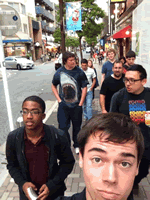
Walking through Tokyo on our first day in Tokyo! We've been doing quite a bit of walking during our first week here. Luckily this allows us to see many things and experience Tokyo close up.
I have limited experience with Spanish in middle school so my exposure to Japanese is tremendously different from all language learning I've taken thus far due to it being the only serious language learning experience I've had. I've noticed that being completely immersed in the language for 24 hours per day is very helpful for practicing the language. In a way, we are being forced to learn the language due to the severe language barrier that faces us every time we go out into Tokyo. Also, having that constant emotional separation between the fascinating people of Japan and me is a strong incentive to learn and pickup the language since I want to converse with them and get to know them. Since the culture of a nation rests with its people, it is essential to learn the language to absorb and connect with the culture. My application of the Japanese language has been limited so far, but very helpful at the same time. I have been able to ask store clerks what prices are and where I can find things. Yesterday the group had to ask a crossing guard where a restaurant was which was a phrase I had just learned that day in class. I've also been able to say "sorry" to people that I bump into on the subway and "thank you" to anyone who has given me anything.
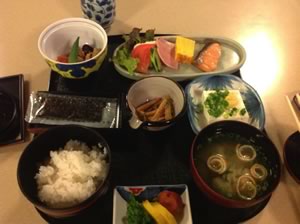
A picture of my first breakfast on my first morning in Tokyo! Food has been a big part of my first week in Japan.
Just like in the states, there are some unspoken rules for how to behave while taking part in the public transportation process. The main difference being that, in Japan, the amount of unspoken rules seems to be much greater. Public displays of affection are generally frowned upon here, especially in the subways. For instance, a young couple in their 20s boarded and proceeded to stand rather close to each other and may have even "snuck" in a kiss during the trip. However, many people in the train car were watching them, including an elderly lady who seemed to be giving a fierce glare to them for a majority of the trip. The couple either seemed not to notice or chose to ignore all the attention they were receiving. This seems to somewhat illustrate the complex generation gap in Japan as well as transportation manners. Although I'm sure that these interactions take place on a daily basis between people, I can't help but wonder if the ones we witness are at all affected by our presence. Being "gaijin" or foreigners, I'm sure the older generation wants us to continue having a favorable and/or accurate impression of Japanese society and culture, leading to a deeper glare from the elder. It is likely, however, that I'm incorrect for thinking that we play any role at all by being present in these scenarios.
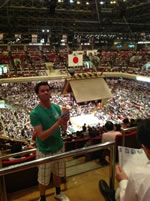
I've heard so much about the sport of Sumo but had no idea how much culture was truly ingrained in Japan's national sport. I was extremely pleased with my experience watching my first Sumo Tournament. In this picture you see me with my ice cream treat in front of the ring where the sumo wrestlers compete.
Typical subway behaviors by Japanese people include reading books, texting on their cell phones, listening to music, and sleeping. Rarely do strangers talk to us and, even more rare, will strangers talk to each other. I am told however that this silence is more common in Tokyo and the eastern side of Japan. Luckily, I'm told that Osaka will have more random social interactions. Keeping quiet and respectful on the subway seems to be the norm. People never eat on the subways. I think this is because of the crumbs and messes that could develop from eating in public and while moving around. Respect for each other and the city is remarkable. This level of respect extends to the absence of littering in the subways and in Japan in general. In America, if you were to go to a public location, litter would be highly prevalent. Is there something wrong with us? We seem to be rolling around in our own filth compared to the Japanese. Perhaps they are just more united as a people than we are. My inner Mechanical Engineering instincts want to take things apart, fix them, and put them back together again, but I fear that American culture has too many moving parts for me to do this.
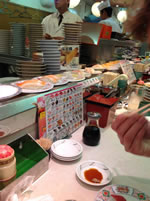
First Sushi - After watching my first Sumo match, I continued to my first sushi bar ever! Having my first sushi bar experience be next to the ocean in Tokyo was truly an experience. Even though sushi isn't usually my first choice of food, it was well priced and delicious (and sometimes shocking). The cooks would freshly make the dishes in sight and hand them to me right off the cutting block.
Language classes are going well still. The great thing about the language learning experience is the sheer interest that it provokes in me. I want to learn more so that I can have deeper and more complex conversations with my friends, lab mates, strangers, and people back home. Sometimes I dream about going back home to the "Osaka Steakhouse" that is less than a mile from my home in Tulsa so that I can talk in Japanese to either a waiter or a cook or someone... anyone. Other days I dream about talking to the very few Japanese students that may come to TU and connecting with them through their native tongue. This is something I've never been able to do for someone and since so many people have been able to connect with me like that I want to give something back in my own way. Ironically, this sheer interest in learning Japanese becomes the worst part about the Japanese language classes when it is overpowered at night by the need to explore and experience Tokyo. Sometimes it's a difficult balance between investing in the language and investing in my own experiences.
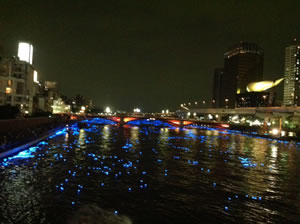
Tokyo's Hotaru Festival - Later that same Saturday, we continued on to Tokyo's Hotaru Festival where they let people throw blue LED balls into the Sumida river. This picture can't quite do it justice but let's just say that the sight of a blue glowing river with Tokyo's sky tree and giant turnip (as seen on the right) was something that I will never forget. I can only dream of Tulsa doing something this cool with the river back home.
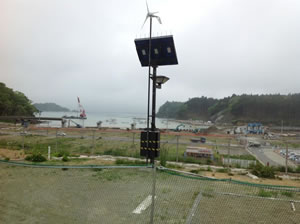
This is the view of the broken bridge and town from the playground the middle school at Minami-Sanriku.
This past week, the trip to Minami-Sanriku served as a grim reminder that the things we see on TV of things that happen very far away affect real people in a truly devastating way. Seeing the flattened wasteland where homes used to stand was something that could never truly "sink in." Nothing can really "warn" you for a moment such as that one. Nothing can truly give it justice. The way the cold wind blew while Minami-Sanriku's joyful 5pm song played over the intercom over the flattened city was stunning. But this reflected how the people of this part of Japan wish to pull together through this crisis and regain their traditional daily lives as much as possible while honoring those that were lost. Arriving at the kindergarten building served as a sudden shock as well. After hearing and seeing and feeling so much of the grief that entombed a city, seeing the adorable faces of the Japanese children revived my spirit. When they all shouted "Arigato Gozaimashita" to us after giving them presents, my eyes started to water just a bit, partly due to how cute it was and partly due to the fact that something terrible had happened just a few years out of their consciousness. I wish I could give them some sort of comfort. Luckily they were too young for the full impact of the situation to affect them today. Running and playing with these children made me feel like a kid again for just a bit. I felt like I had just discovered paper airplanes for the first time! Then when I was being chased around, I remembered what it was like to run on a playground.
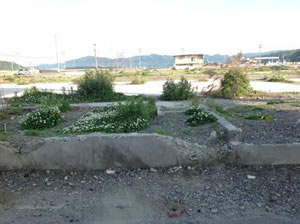
At first it seems like a parking lot due to how flat and gravely the ground it. But soon you realize that it's more like a wasteland.
Seeing the middle school was equally as emotionally confusing at times. From the 3rd floor of the middle school, the windows clearly showed the wasteland that used to be their town. As our groups of children made bridges out of chopsticks, it was disheartening to look out the window to see the shattered bridge that rested outside. Large cranes pulled chunks of concrete out of the ocean while children rushed and played with different bridge designs here inside. Visiting the Minami-Sanriku Sun Sun Shopping Center was eerie in a way. The mix of emotions throughout the trip was rather harsh at times but overall, it was a valuable experience that gave me a sense of childhood while also providing humility. During these past two weeks, my home state of Oklahoma was struck by multiple tornadoes, killing over 40 people, injuring hundreds, and bringing destruction to many towns. When I tell people here in Japan that I am from Oklahoma they always ask me if my family is alright. It never stops surprising me how people over here are so aware of the tornadoes in Oklahoma. Sometimes I feel like our tragedies connect us in a strange way that makes me happy for humanity. Since disasters are fairly rare in Japan, the 3/11 disaster, an event that would be considered horrific anywhere in the world, was even more stunning. The 3/11 disaster served as a reminder that nature is an all powerful force. However, it also showed how scary nuclear radiation can be when coupled with a horrific natural disaster. Having the KIP students around during the Minami-Sanriku trip was a great value to the experience. Being able to see how native Japanese people show respect for those who were lost during 3/11 was a good example for us. Having them there made it easier to manage the cultural boundary that went along with the social circumstances of a disaster zone.
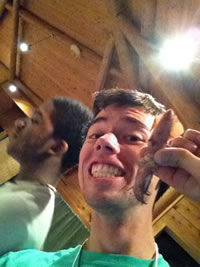
This is a picture of me trying my first raw squid!
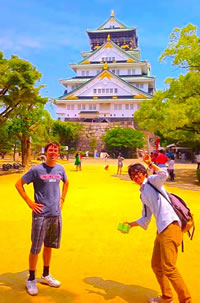
It was a beautiful day for castle hunting with a couple of my lab mates visiting Osaka Castle!
I was extremely excited to start my research here at Osaka University and, luckily, this excitement was for good reason. On the first day, after attending an article review seminar in the morning, I was treated to a game of basketball with my lab mates. This could have been embarrassing since I haven't played much basketball in my life. However, one does not travel to a country like Japan without expecting to be a little embarrassed. Since most of my lab mates have spent so much time studying and doing other things besides sports, I was able to fit in quite well. None of us will be going pro anytime soon. I hit another stroke of lucky when it came to soccer in the evening. I've always seen soccer to be one of my worst sports due to the fact that most of my soccer-playing friends back in the states are very talented. However, yet again, I fit in quite well with people who see sports more as a way to get out of the lab. They always have fun here in LaSIE. I ended my first day feeling extremely lucky to be in this lab! Everyone speaks English very well, acts extremely hospitable, and always has fun!
My Ph.D. mentor is Shota Ushiba. He went to Rice two years ago for the 2011 Reverse NanoJapan Program so he has some of the best English skills and also acts very friendly. During the first week, he invited me to play sports with the lab on the first day, to watch the Japan vs. Australia soccer match at his friend's house on the first day, and to go bowling with some of the lab mates on Friday night. He is one of the main reasons that my first week in Osaka has been so enriching and exciting. I've read that being invited to the home of a Japanese person is a rare experience for a geijin (foreigner) so I was incredibly honored to yell at an exciting soccer match while making sushi in a Japanese home during my 2nd day in town.
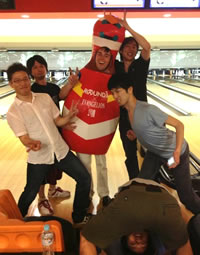
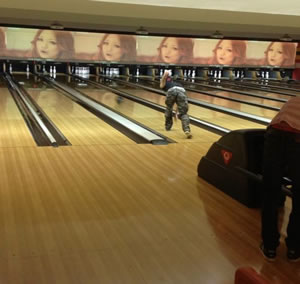
Crazy fun times at the bowling alley with lab mates!! This is someone in the lane next to ours. Absolutely shocking how far he goes over the foul line while bowling.
I'll admit, I see myself as a decent bowler so when Friday night came around, I wasn't nervous about my skills. After bowling a measly 83 against the mid 100s of my lab mates in the first game, I was a bit more rattled. Luckily I was able to work my way up throughout the night for a high of 138 to save face. Also while struggling during bowling, I was able to experience my MOST SHOCKING CULTURAL EXPERIENCE thus far. Before my arrival to Japan, I was thoroughly warned about the toilets, raw fish, lab hierarchy, gender division, language challenges, and driving styles so those things were not really very "shocking." But no one ever warned me that Japanese people will sometimes go 1 or 2 meters PAST the foul line while bowling! About half of the Japanese I observed at the bowling alley would not cross the line when throwing so this is not 100% true for every Japanese person. However, in the States, every bowling alley I know would disqualify the throw if the bowler stepped over the line so I wonder if Americans would be the same if bowling alleys relaxed on this rule. Anyway, it was a blast and I look forward to bowling again!
Since most people in the lab are able to express their thoughts quite well in English, the language barrier is not a problem for my research. However my curiosity and desire to learn Japanese has proven to be a valuable subject for discussion and cultural exchange. I highly value each slang term that they teach me since using these words around other students often makes them laugh and can be an easy way to make friends. These terms should be used with care however since they are highly informal. My dorm here isn't at all similar to the high quality hotels we've been staying in so far but this was expected since the rent is quite cheap. Luckily, after spending a whole year living in an all guys international dorm back at Tulsa I'm prepared for such experiences regarding low quality dorms. However, in some ways, the Suita International male-only dorm has surpassed previous living arrangements in strange ways. Yesterday morning while walking down the hall, one of Japan's supersized crows flew right in front of me from the kitchen since somebody left the outside kitchen door open. This was surprising but I'm sure he was more scared of me. I'm more than happy to face these challenges because this arrangement will allow me to experience more things in Japan and bring back more souvenirs to my friends and family! People who are not used to such living should be warned though.
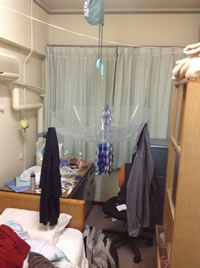
I might be a Mechanical Engineer... a lack of dryers in the dorm leads to innovation!
Every morning I take a 30 minute bike ride to campus uphill. Hopefully this will keep me skinny even with all of my snacking on Japanese deserts! The bike that I was loaned for the summer wasn't quite what I expected and I almost fell off it a few times. However, I raised the seat and adjusted it myself so it has proven to be a worthy metal steed equipped with a large front basket, backseat ("for the ladies" we joke), and a bottle dynamo that powers a front headlight. If I had not done research on trying to make an electric generator on my bike back home in Tulsa I would have had no idea what the dynamo was or how to use it so this may prove to be useful information for others.
During my first day at LaSIE lab here at Osaka University, my professor advising sensei, Shoji-Sensei, discussed with Kawata-sensei about my project. Shoji-sensei was inspired to make CNT bubbles while blowing bubbles with his son at home. So my project is to make CNT bubbles and analyze them with the Raman microscope. Since previous research only used an Atomic Force Microscope to analyze the alignment of CNTs inside the surface of the bubble, our research will be able to further investigate the claims that they made using Raman Spectroscopy. It is expected that CNTs align themselves with the slope of the bubble, pointing towards the center. CNTs on the top of the bubble are more randomized, however. It is theorized that as water molecules travel down the surface of the bubble they push CNTs into alignment.
I started research on the 2nd day here in Osaka and things got moving quickly. I'm researching Carbon Nanotube Bubbles! This has come as a strange but interesting shock. My advising professor laughed when introducing the topic to me because he knew it was a strange research topic. He admitted that it's kind of a funny project with no known applications to the real world but I'm enjoying it so far so it's not all bad. On the 3rd day in Osaka I became an expert at creating very tiny bubbles to analyze in the Raman microscope only to be told at the end of the day that I should be trying to make larger bubbles (this was funny if you had been there). Using and understanding the Raman microscope is an extremely satisfying experience and makes me feel like a scientist. The Raman microscope is what sets our research apart since previous research only used an Atomic Force Microscope (AFM) to analyze the alignment of CNTs in the bubble's surface. I'm excited to pursue this topic but at times it is demoralizing to know that no one has thought of any purposes for CNT bubbles. Perhaps it is my job to think of some.
Since the orientation program at Rice was so thorough in preparing us for the cross-cultural conflicts that may arise, I haven't had any misunderstandings that have ended with significant social trauma. I also believe that my upbringing gave me certain social characteristics that are more similar to Japanese social characteristics than most Americans'. The gut feelings that I get are highly beneficial in social scenarios where mixed messages may be perceived.
Just recently in Nara, JJ, 4 of my lab mates, and I entered an okonomiyaki restaurant that had a choice between traditional Japanese seating (kneeling around a short table) and chairs around a regular-height table. The Japanese students led the way and sat at the higher table. Although I'm more than excited to try every bit of Japanese culture, it is difficult for American legs to fit into the tight spaces presented in authentic Japanese restaurants so I've tried to avoid such sitting scenarios. Near the end of the meal I got curious and asked, "so if JJ and I hadn't joined, would you be sitting over there?" as I gestured toward the more traditional seating. My question was met with a somewhat uncomfortable silence. My gut instinct quickly told me that I had struck some sort of touchy subject. "So that would be a yes? That's fine I was just curious," I stated. My two lab mates gave an uncomfortable sign that I was correct, nodding shyly with a hint of shame. It was as if I found out a little secret that they were hoping to keep from me.
I apologized for changing their routine and thanked them for my comfort but I went away from the experience feeling as if I made them somewhat uncomfortable. Luckily this has been my most displeasureable social experience so far and it was certainly not unbearable. It is apparent that they don't want me, as a guest, to think that I am hindering their own comfort and happiness. Although it has been amazing to be their guest this past month, I may need to start taking Packard-Sensei's advice more seriously about trying to rid myself of the "guest" label. Next time and from now on I will ask for my lab mates to carry on as they would if we were not geijin, even if this includes becoming very uncomfortable in traditional Japanese sitting situations. This would not only allow for me to have the full Japanese experience but it would also send my lab mates a message that I am willing to do whatever it takes to respect their traditions and appreciate who they are. Hopefully this will open up cross-cultural communication even more (even though this hasn't been a problem since I have one of the most social and most fun labs in the whole world!).
Sidenote: Yesterday a new face appeared in the lab, a master’s student (I think) who was in his hometown for the past 2 or 3 weeks. Within the first 5 sentences of conversation with him, I was able to use my Japanese slang to make him lose his breath from laughing. We became friends rather quickly. Perhaps I should pass on a couple of these words to other NanoJapaners! Hopefully their labs have a good sense of humor like my lab.
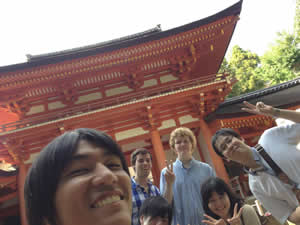
Beautiful day to explore temples in Nara with lab mates and JJ!
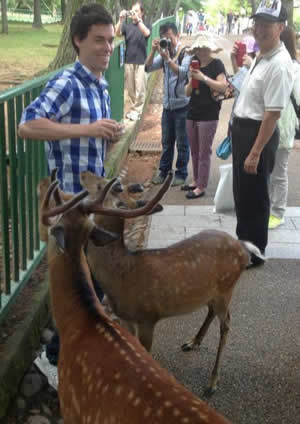
Feeding the Shika (deer)! at Nara! I had no idea that there were so many strangers taking pictures and laughing at me while these shika were physically trying to get the shika senbei (deer crackers) that I had.
皆さんは私を笑いました!
"恥ずいがいじん"-me
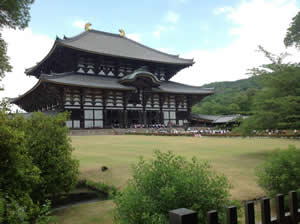
Awe-inspiring site. Home of Nara's Big Buddha. Tōdai-ji
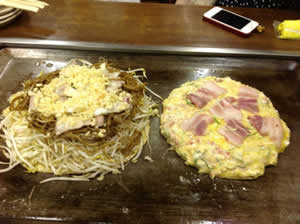
Kansai region is known for its amazing Okinomiyaki! I'm not good at cooking but when I get back to the States I will try my best to find the ingredients and skills necessary to imitate this food.
Research Update: After sonicating our last sample, we put it into a centrifuge and now there are very few chunks, if any, when we start the day's research. We start each day with a 1 hour sonication of this small sample.
Last week we were able to get data from polarized Raman spectroscopy that supported the claim that CNTs were aligned pointing towards the center (this can be found in Power Point #1. After 2 days of this week, we spent 1 day looking at Atomic Force Microscopy images that showed no nanotubes and today we spent the whole day analyzing a bubble sample that showed no alignment of nanotubes so things are somewhat difficult this week so far. These results can be seen in Power Point #2 labeled "Jun 18th bubble." Luckily, Ushiba-san has been very positive even about inconclusive results so this keeps me positive as well. The AFM has been a confusing problem thus far. My post-doc lab mate, Masui-san took over for Ushiba-san on Mondays and Fridays since he has a TA job those days. We decided that heating the sample to 300*C would dry the sample and allow it to be read in the AFM. However, after this and a few other trials we weren't able to see any CNTs in the AFM anywhere on the bubble remains.
Although I have conducted research back home at the University of Tulsa, there are too many variables besides just cultural and language differences for me to accurately characterize the unique qualities of my Japanese lab. For example, my lab back at Tulsa consisted of a master's student, a Ph.D. student, an assistant professor, and me, but my lab here in Osaka has about 25 members ranging from 4th year bachelor students to professors. However, some interactions are clearly different due to culture.
At random points during the day, sometimes people start vacuuming. I'm not sure if there is a list or schedule somewhere that tells people to do this or if they just saw a crumb on the floor. Yesterday two people decided to vacuum at the same time without communicating that they were doing so. This makes me think they just like keeping things clean. I'm wondering if, to fit in, I should start randomly vacuuming too. Also, every night, a different person disposes of the trash in the office. I'm not sure how they know who's turn it is. I should probably ask about this. (Update: Just asked. Turns out there is a calendar hidden away in a corner that has a schedule. I plan to invade this somehow on my quest to truly be a member of the lab).
Every morning people trickle into the two large joined office rooms from around 9am to 10:30am and greet everyone with a quick "gozaimas." B4s (senior undergraduates) typically go home first. Starting at 5pm they leave the office by saying "otsukarei sama desu." After that, there is little correlation between year and leaving time. There are a few people who sometimes never leave the lab and just spend the night. I once returned from karaoke to retrieve my belongings at 3am on Friday night/Saturday morning and 3 people were still here working! Apparently it is kind of a right of passage to spend a night in the office. My Ph.D. mentor, Shota-san suggested that I sleep in the office one night for the experience and I think I'll try it out eventually. It's 8pm as I'm typing this and close to 50% of the lab is still here! Although work gets done and it's still an "office" I can't shake the feeling that this is more like a living room and the lab mates are a family. You never feel lonely here even if everyone is quietly typing away. This makes staying late in the office easy to do for most (including myself). I often stay past 9 or 10 studying Japanese and sometimes talking with lab mates.
The family metaphor extends to the hierarchy of the lab as well. I've observed the relationships between lab members, tried my best to replicate these behaviors, and found that the way I treat higher ups is similar to how I treat upper members of my own family tree. The main difference is that "sir/ma'am" has been replaced by "hai." Also, I'm reminded almost on a daily basis that I am extremely young. "ju kyu sai desu" (I'm 19 years old) is always followed by a startled "Wakai desu ne!!" (You are so young!). It is an extreme advantage to be young however. It's clear that less is expected of me since students my age don't usually work in a lab or even have lab experience like I do. I see every day as a chance to impress my advisors and I feel that some days I succeed. A few days back I made a suggestion for the design of an experiment that I thought was a simple change. This suggestion was met with an enlightened "I haven't thought of that!" and a pat on the arm from my advising sensei. About a week ago I made a suggestion to my advising sensei about an entirely new method for bubble synthesis and he followed up yet again with "I haven't thought of that!" I was later told that this new dynamic to the research could be the "new and different" thing that makes my research project stand out from similar projects in the field.
So far, most of the scary things that I've been warned about during the Tokyo lectures have been unfounded. Although it is typical to witness a sensei rip apart a lower ranking individual's research with difficult questions in English (not so easy to respond on the spot to complex questions in your non-native language), I haven't felt discouraged to speak or ask questions during a lecture or presentation. For the most part, the small group meetings here have been highly similar to the lab meetings back at my Tulsa lab except meetings here are much more understandable due to simpler content and slower explanations. Perhaps I haven't had a big enough sample of lab life in the US, but lab life is much more enjoyable so far in Japan. Being able to be a part of a lab family is something truly amazing and I can only hope to get a feeling like this again back in The States. There have been many times back home when my little lab felt like a lonely place so Kawata lab offers a heavy contrast in that respect. Having more people in a lab also benefits your research as well. When I give presentations here, other students ask hard questions and make me truly explain concepts and therefore force me to understand what I'm doing. Sometimes they give very insightful advice for research.
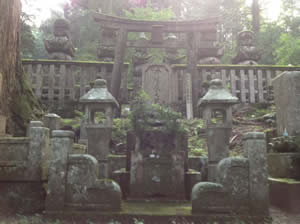
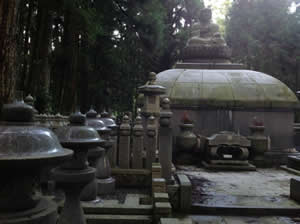
Spent the night at a Buddhist Monastery on Mount Koya and toured the Buddhist/Shinto graveyard that was there.
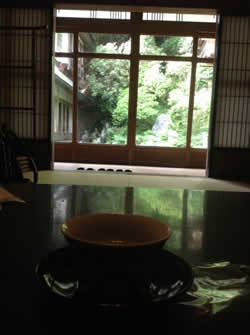
This is our room in the Monastery. As soon as we got there, a monk brought us tea and explained where to get dinner since we didn't buy a meal plan for dinner that evening (so nice!) so we went to a tiny little restaurant in town. It was basically a little kitchen inside someone's home and everything was made right there in clear sight by a nice woman. Every Japanese person we encountered was ecstatic when we could speak just a few words of Japanese. The bar has been set abysmally low by foreign tourists as far as Japanese language skills are concerned so every time we speak we get a compliment. It's quite strange but also hilarious every time it happens... because it always happens.
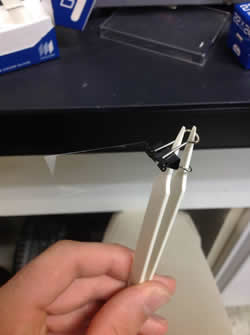
It always comes in handy to be a MechE. However it could have been worse. I could have found duct tape. The purpose of this was to keep me from cutting my hands on quickly spinning glass substrates as I try to catch a bubble for my research.
Research Update: The Nano bubbles are going well for the most part. The new idea that I suggested was to spin the bubble while the substrate is being placed on it. I made one sample at 650 rpm but we have yet to analyze it with the Raman microscope. Perhaps we will get some sort of different alignments out of this. Also we hadn't found any conclusive evidence of CNTs via AFM until a couple of days ago. We found very few CNTs and we are going to try changing the concentration of the sample to see if that makes them show up on our images. There were some strange looking white blips on the image that we suspect may be surfactant. I suggested a simple test where we make a mixture with no CNTs and see if the blips disappear. I'm also making another sample with a separate surfactant so we can see if it is only one surfactant that does this under the AFM.
Most of our experiments thus far have been with just a normal bubble and it's starting to become slightly tiresome to run the same tests over and over hoping to get a consistent result with the polarized Raman readings. We change the polarity of the light to read how aligned the CNTs are since CNTs that are parallel to the polarization of light have a higher Raman intensity than CNTs that are aligned perpendicular to the polarization of light. I'm really excited to analyze the spun bubble sample but we have yet to make time. I'm not entirely sure why we are not getting consistent result with our alignments. The base paper said something about waiting as long as possible for the CNTs to align so this will be the next thing I stress for the next bubble synthesis.
Outside of research, my life here in Osaka is mainly consumed by studying Japanese, connecting with my lab mates, and exploring the city. In these activities I have garnered significant self-accomplishments.
Throughout most of my life, I never took learning a 2nd language seriously and found myself regretting that decision as I entered college. However, this summer, I've been presented with an astounding opportunity to live, think, and breath a whole new language. During my stay in Japan, I've felt a sense of satisfaction when I am able to find English equivalents to Japanese words and phrases or identify differences that cannot ever be translated. For example, the Japanese language does not have capitalized letters. I found it quite amusing trying to describe how USING ALL CAPITAL LETTERS IN A MESSAGE TO A NATIVE ENGLISH SPEAKER IS LIKE YELLING AT THEM. Since this is quite an amusing affect our language has, I want teach it to my Japanese lab mates. Capitalization can also draw a parallel to the honorific system that is in place for Japanese names. Just as you should always capitalize words such as names, "I", and "God," Japanese names are always followed by an honorific such as "-san" or "-sensei." After going to church this past Sunday it was interesting to hear God referred to as "kami-sama," since "-sama" is a high honorific used for other individuals that you highly respect.
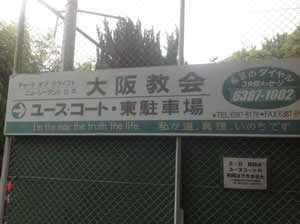
Went to this Japanese Church Sunday morning! Its mother church is from New Zealand! The whole experience was astoundingly similar to my church back home except everyone was Japanese and the service was in Japanese. Luckily they had a little ear bud that you could listen to an English translation during the sermon. They fit in about 100 people or so for a good-sized crowd. Met a very helpful man right as I was parking my bike who drove me to a convenient store to get lunch. His wife wanted me to speak English so she could improve. Most people I ran into could speak a little English so all was well for communication if my Japanese wasn't adequate. Most of my interactions were me speaking Japanese and them speaking in English. For some reason that's how many interactions go in Japan. I think this is because we aren't totally sure the other party will understand us if we speak our natural language. I met a Japanese guy who went to college in Tasmania so he had a thick Australian/Tasmanian accent! Also there was a nice Chinese woman who had just finished her master's degree at Osaka University who also spoke English well. I got one of the most ecstatic "WAKAIIIIIII!"s (SO YOUNG!) from her and her friends after I told them my age. After coming back from lunch they had something called "Happy Hour" where they had some bible games and let the kids play along with a lesson for the adults. Quite adorable in all. I'm rather sad that I can't come back because I'll be busy for the rest of my stay.
Also, I'm getting to the point where I'm able to memorize many words at a time because I can connect them to kanji. The more I think about it, kanji is much like the etymological roots of our English words. Just as the word "aquarium" is composed of the roots "aqua" for "water" and "arium" for "place for relating to," the Japanese word for aquarium "suizokukan" has the root "sui" which from the kanji for "water," "zoku" which is from the kanji for "tribe/family," and "kan" is the kanji for "building." Connecting words to each other through kanji makes remembering them much easier. I've also noticed at times that I think in different patterns because I've been thinking in Japanese so much. For example, in Japanese, instead of using the format (affect) "because" (reason) you have to use (reason) "kara" (affect). Sometimes it is difficult to form sentences due to the flip flopping grammar from English to Japanese. Luckily I've been able to create English substitutes for these ideas to help me form sentences on the fly. For example, I simply change my thought pattern from (affect) "because" (reason) to a slightly longer phrase (reason) ". Because of this..." (affect). Learning Japanese can be an engineering challenge in itself. Luckily I am a Mechanical Engineer and words can be like duct tape.
Connecting with lab mates is another accomplishment I've been able to take pride in. Learning slang terms still proves the best way to quickly bond with younger Japanese people. Today I was even able to teach Professor Kono some Japanese slang! Perhaps now he'll be able to make friends too (haha)! Teaching a Japanese person Japanese words is something I can now check off my bucket list. Today I was able to have a conversation over dinner with one of my lab mates! This means that when I get back to the States I'll be able to converse and connect with Japanese speakers back home as well!
This was a highly needed experience since last week I faced a highly demotivating moment with my Japanese while watching a Japanese movie. Even after rewinding and listening to sentences from the movie multiple times I was still unable to decipher the sounds that were being made let alone the words. Accepting the fact that I will not understand most of the Japanese I hear is one of the most difficult personal challenges I've had to face. I do remind myself that I have only studied Japanese for two months. Luckily, tennis has taught me to always stay positive during some of the most frustrating times and this optimism has been rewarded this week with multiple successful conversations and connections.
Side Note: I may sound like a typical boy when I say this but I met a French girl from a lab down the hallway last week and now I want to learn some French as well. She does not understand my Louisianan French! In general I want to learn more of many languages. However, at the moment, I am too busy learning Japanese. When I get back to Tulsa I plan on learning a few more Arabic phrases to connect with the middle eastern students and some Chinese too.
My research seems to be going well! After presenting my research to Kono-sensei and Sarah-san I analyzed some data taken from the day before and realized that there is a completely new and exciting property of CNT bubbles that I will base my future research on! The future for my CNT bubble research seems to be very bright but I am saddened that the limited amount of time will not allow me to pursue this research as deeply as I desire.
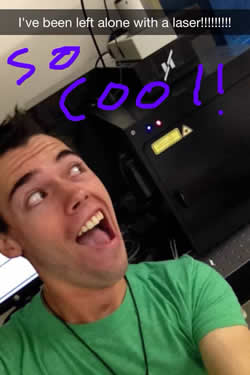
You know research is going well when you're allowed to take data and make decisions about experimental design on your own! However I'll miss being able to say that I have a Ph.D. student (or sometimes a Post-Doc) as a lab partner. Sometimes trapping a native Japanese speaker alone in a room with you is the best way to get practice speaking and listening Japanese.
The Mid-Program Meeting served as an excellent way to reunite the NanoJapan group for cultural analysis as well as a once in a lifetime way to relax on a tropical island while being spoiled by a rising university.

I would strongly recommend continuing to have the Mid-Program Meeting at this location because it allows for all the NanoJapan students to see this entirely unique university that Japan is building. Being informed and spreading the word about OIST seems important to its success. The cultural diversity seems unparalleled and the financial support a student could receive matches the best universities. All of the staff that I was able to talk to seemed friendly and especially passionate about scientific discovery. The graduate studies at OIST, due to having a much smaller student body, is able to highly individualize course content to each student. Usually in the US and in Japan, graduate students can only work on the programs that their advising professor wants. However, OIST allows the students to choose programs for research and study. Occasionally the courses that the student requests are not able to be taught by any of the professors at OIST so they send that student to another prestigious university somewhere else in the world for a period of time to learn. This is a very rare trait for a university to have and should be made known to students and faculty around the world.
Snorkeling is something that I've only been able to do in neighborhood pools up to this point so being able to do real snorkeling out in the clear ocean waters of Okinawa is now an experience to brag about. Also I don't think whale sharks are a common animal in most American aquariums so seeing them in the two Japanese aquariums I've come across is entirely new as well. I'm glad things were not over scheduled or squashed into a tight timetable so much. I think one of the best things about a program like this is that I don't have to worry about rushing to places and stressing out about making the most of every minute. Having the chance to relax and not worry about rushing makes Okinawa and NanoJapan a unique and enjoyable experience. Please keep the program like this in the future.
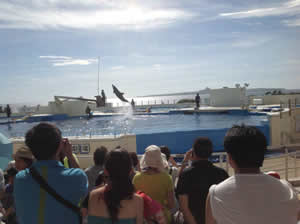
As soon as I was accepted to the NanoJapan program I saw this as a great opportunity to learn a 2nd language. Even though I was presented with plenty of opportunities to learn other languages (usually Spanish) in middle school and high school, however I wasn't mature enough to see the importance of doing so. Another theory is that I was scared to butcher another language so badly and mess up. However, this past year I've been more open to trying a new language and as soon as Japanese was offered in such a way, it became an obvious choice. After these first two months in Japan I've come to the conclusion that Japanese is probably the friendliest language to learn. This is partly due to the fact that Japanese people are so friendly and polite. Since most foreigners come to Japan knowing hardly any Japanese, one month of Japanese classes in Tokyo was enough for me to garner countless compliments on my Japanese. Although I know my language skills are nowhere near good (you can only learn so much in one month) it must be somewhat refreshing for Japanese people to know that foreigners are taking the effort to try to learn the language. Being able totalk to the people so quickly because of this is one of the more rewarding aspects of the language.
In other languages such as Spanish or French, one month would not likely be enough to garner any such compliments. Japanese words are also very friendly to foreigners especially to English speakers. Besides the "r" sound, we are pretty well equipped to make every sound in Japanese syllables. Also since each katakana and hiragana character has only one reading, being able to look up a word means immediately being able to correctly say the word and to be understood. Going back and looking at the few French words that I know, being able to spell them doesn't at all mean I know how to say them correctly. So even though the Japanese language looks difficult, this is one of the characteristics that makes it far easier to learn than I initially thought. Also since katakana is often used to translate English words to Japanese, being able to read and speak in katakana automatically adds many words to an English speaker's lexicon.
After orientation I was very well equipped to answer all of the basic questions that would be asked of me by strangers and by lab mates so for that I'm thankful. However, the first month they teach us formal Japanese and since dictionary words are often written in more casual forms, it was a slight challenge being able to use and interpret words that I looked up in a dictionary. Studying Japanese in the lab has been a highly effective way of bonding with lab mates. I am extremely lucky to be in a lab that has more Japanese people who also speak English well enough to teach me Japanese. From what I've heard, other labs either have so many foreign students that English is predominant or not enough English is spoken to teach NanoJapaners Japanese very efficiently. My lab matches my needs and skill sets very well with language and research. I'm hoping to improve my Japanese enough to score higher than any NanoJapaner with no previous language experience who has come before me. Perhaps I'll even write a short guide for future NanoJapaners so they know how to make the most out of the awkward amount of Japanese they learn in the first month.
Some of my most challenging linguistic experiences occur when going to stores and shops near my dorm. About once every couple of weeks I go out on my own in the evening to different places in my area of Osaka with my ipad to ask questions about goods and food. I've nicknamed these trips "ipad adventures" since I'm looking at my ipad dictionary most of the time trying to formulate sentences to ask. Because I wanted to get a manga (Japanese comic) for a good friend back home, one ipad adventure took me to a local "culture shop." I decided to ask a storekeeper for a "new and exciting manga." It seemed like a fairly simple question. However, as I've come to learn, simple questions are not always met with a yes or no answer or even pointing in a direction, especially in Japanese manga shops. After hearing my question, the shopkeeper went to the employees only area and brought back 4 more guys dressed rather casually. They all began to collaborate on my question speaking quickly in Japanese. It is clear that they were passionate about their love for manga. Because of this, I didn't feel as if I was intruding or being too bothersome with my question. (During previous ipad adventures I would feel like I was being a burden so I would end the interaction and leave so this was a good chance to practice Japanese without being in the way.) They asked me a few questions that I had no idea how to answer. As they realized I didn't understand, they began acting out their meanings. Using charades, they told me that some books were quite violent and I think they even acted out some sort of love scene to show that one manga was more lovey-dovey! Usually the ipad using part of my adventures takes place before I begin interacting so I don't waste the time of the answerer, however this time I was forced to scramble through my dictionary for the right word in the middle of the conversation. I also found myself asking them to write their questions in my dictionary for translation since I had no idea what they were saying. This is the part where the simple pronunciations of Japanese hiragana come in handy for on-the-fly translations. At the end of the night I was able to come away with a fun new manga to give once I get back home.
However, for now, it will serve as a language learning method as I try to interpret it. One thing that I've learned about communication: Language barriers don't matter if you're talking about something you're passionate about. People will find a way to express their feelings if it is important to them. I hope to continue studying Japanese when I return home but my University does not currently offer any Japanese language classes so I will continue my self study with the Japanese intern that is expected to arrive and with any Japanese students who I'm lucky enough to run into. I enjoy being able to go at my own pace through self study and then using what I've learned on native Japanese so I doubt I will be enrolling in any classes anytime soon. I want to be able to go to Japanese restaurants or specialty stores for the rest of my life and make conversation to describe my adventures so I am looking to at least maintain my level of Japanese skills once I get back to the States.
Side note: At times I've tried to replacements for the word "NanoJapaners" such as "terahertz crew" or "THz crew." It should also be known that the triumvirate of JJ, Xavier, and me that was formerly know as the "Kansai Krew" should now be referred to as the "Kansai Kazoku" (kazoku being the word for family). Other THz crew nicknames are as follows: Sendai Squad, Hokkaido Hitori (hitori means one person) Team Tokyo.
Research Update: Recently we've been finding some strange alignments of CNTs in the boundary of the bubbles. For a spun bubble, we saw on three different parts of the bubble boundary the CNTs were aligned pointed towards the center of the bubble. Also I made one bubble where I didn't press down as far upon the bubble during the substrate transfer process and I got no alignment on the inside of the coffee ring but horizontal alignment (pointed towards center) on the outer edge of the coffee ring. I'm not quite sure why these two strange results happened but Ushiba-san says we should think about the mechanics but mainly we should continue getting research data to see if we can solidly support these claims of strange alignments. Also in the most recent data, we obtained some of the strongest alignment yet seen in a regular bubble. Raman intensity at 90degrees was almost 9 times stronger than that at 0 degrees. Attached should be a powerpoint with data.
This past Friday a "welcome party" was thrown for me by LaSIE's materials group (the group that I'm doing research for) at a Chinese restaurant in one of Osaka's most famous districts. At the train station that we arrived at, we met up with my advising sensei, dressed in a striped t-shirt, jeans, and sandals. This was the first time I've seen him without a collared shirt on (casual modern Japanese clothes). This was clearly relaxation time, even for professors. However, the students always yielded when he chose to speak. Even in these most relaxed scenarios, the sensei is still the sensei.
As the night went on and the conversation began to flow, my advising sensei began to passionately discuss any topic that he pleased, even video games. I have never seen a professor become so intense when discussing PlayStation and Sony! That was later followed by a personal story about how he disliked having to learn English as a high school student and how that kept him from getting into his preferred university for undergraduate. Near the end of the party, as we were all still sitting at a traditional Japanese style table, he asked the group a fairly serious question about how the group meetings were conducted. "Should we continue to have weekly meetings every Friday? I don't want to waste your time with it and I'm the only one who seems to ask any questions." Even though the conversation seemed to be loose up to this moment, the students of the materials group had no response for this question. It was a reasonable question to ask since most of the time, questions are only asked by the sensei during meetings. However, making presentations, especially English presentations, on a regular basis is good experience for these lab members. Even with such an important question hanging in the room, the lab members weren't giving any analysis or suggestions. I feel that if this question had been asked in the States, it would have been met with quickly collaborated opinions instead of cautiousness.
However, I remembered back to my training during orientation during this moment. In some situations, Japanese labs see American approaches as beneficial so I decided to step in with a controlled dosage of Americanism. "Maybe one meeting every two weeks will be better I wonder," I spoke, using two soft uncertainty words that Japanese people commonly use to make suggestions. Although I know I will not be here long enough to take part in any new meeting structure, I felt like breaking the ice might allow the other students to speak their minds freely. After my comment, a couple of other students gave some timid input but it certainly wasn't the ice breaking that I imagined. I'm not entirely sure what I should have done in this situation so I cannot promise a clear answer. Perhaps the best way would be to have a secret ballot for decided the meeting style or maybe the group should try a few meeting styles to see which one will work best for the future. All that I can advise for future NanoJapaners is that you should remember your place (you're only here for 2 months as a low ranking member of the lab), but also remember that the courageous, brainstorming, "team work" culture you've been brought up in is valuable to your lab.
Side note: While typing this, I was able to expose my lab to the use of "bless you" after someone sneezes. Although the office was very quiet before the sneeze, after the sneeze and the consequent "bless you," a few lab mates chuckled because they had only heard of its use in books and movies! They also seemed interested to hear that Americans, even the non-religious, usually bless sneezers.
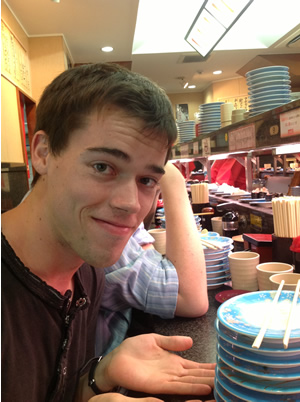
I think I'm starting to like Sushi!! One of JJ's lab mates showed us some different places in Osaka today including an amazing sushi restaurant.
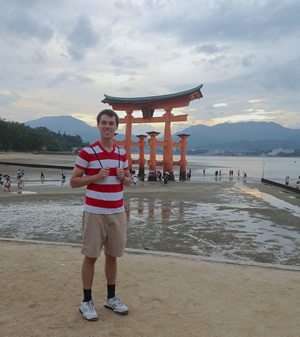
Usually the water level makes this a "floating" Torii gate but today it was just a normal one. Still makes for an amazing photo opportunity!
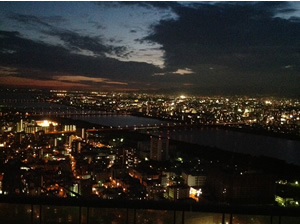
View of my summer home, Osaka, from Umeda's Sky Garden
Right after my final presentation in LaSIE today I was able to obtain a solid half hour to talk to Kawata-sensei, the head professor of my laboratory. I wasn't able to record the conversation so these are loose recounts from my notes of the interview I had with him.
Me: You always seem so busy with your work. How do you balance your work life with life outside of your work?
Kawata-sensei: This is my life. I live with my wife and 2 cats here in Osaka but at the same time, I'm always traveling. Occasionally I'll visit my son in Tokyo. Also while traveling I always have things like Skype and the Internet to talk to my family. I have one Daughter here in Osaka that I get to meet with occasionally. My other daughter is in South America so sometimes that's the only way to talk to her for long periods of time.
Me: As a young researcher looking to become a professor, what advice might you offer me for the years ahead?
Kawata-sensei: It's always busy. Especially when you get around to being 45-50 it gets extremely busy. You'll have to be ready for a busy life.
Me: Did you play a part in encouraging your children to go to University abroad?
Kawata-sensei: I never knowingly encouraged it. However, occasionally traveling abroad with them exposed them to more things than just Japan.
Me: I've certainly felt more open to going abroad after leaving the US for the first time this summer so it's easy to relate. Is it frustrating for you and your students to be forced to learn English in order to do research on an international level? Kawata-sensei: In many ways it is frustrating. It's tough for our students to have to learn both complex scientific ideas and English. Also at times during research, it's difficult to tell if a problem is due to scientific misunderstanding or due to a communication error.
Me: Did you feel these frustrations during your time as a student?
Kawata-sensei: Well during most of my time as a student there were not foreigners in the lab. I didn't see foreigners in the lab until I was doing my Ph.D. I didn't learn English until I was about 27. Then from there I was forced to learn English as I went to an American university for my Post-Doc.
Me: How were things different between your Japanese lab and the American lab you moved into?
Kawata-sensei: Everything. Of course, the language was different. Like you said, Americans are generally more direct about things. But also the American lab had a majority of foreigners. The Japanese lab was basically all Japanese. Also they didn't treat me as a guest the same way it seems you've been taken in here. After a certain time of day, all the Americans went home to their family or friends I suppose and then the lab was just foreigners. Luckily, back in those days, without being able to speak much English I could get by with just pointing at things like menus and signs.
Me: Sounds kind of like us NanoJapan students haha! Were you able to bring back any of the qualities of the American lab to your lab here? Since you're pretty much in charge it seems like it would be much easier for you to do.
Kawata-sensei: I feel like I made this a more hybridized lab, yes.
Me: In what ways can you think of?
Kawata-sensei: When I was in America, they had programs set up where international students could go for help especially if they didn't speak English. Because of this, I've wanted to help out international students here as much as possible. I've had the opportunity to let international students here in Japan stay in my home. I feel like it's important to make sure that international students are well cared for. Perhaps this more international culture at home influenced my children to go abroad. Also, my first child was actually born in the States. When I came back to Japan and my 2nd child was born, I faced a sort of reverse culture shock coming back. In America it's common practice for the father to remain in the room while the mother gives birth. However, when I returned to Japan, they told me, "There's nothing else you can do here. Go home and we'll call you."
Me: Was that discouraging?
Kawata-sensei: It was shocking. Also the baby food is different. In America they had it all ready for you, but in Japan you had to prepare it yourself. Little things like that.
Me: Do you see it as being important to have more international Professors and students in order to maintain your lab's prominence as an internationally known laboratory?
Kawata-sensei: It's certainly important especially as science becomes more and more international. Talented scientists come from every country and it's important to have them in your lab. We've had a few international professors here.
Me: Can you see a foreigner ever becoming the head of a research laboratory like you are here?
Kawata-sensei: It's been done before here in this university (gestures down the hall). The biggest challenge usually isn't whether they are a good enough professor, however. If you're in a position like that, you need to be able to communicate well enough in Japanese to other officials. Being the head of the lab requires more responsibilities than just talking to students and other faculty in English. American and Japan are really similar. Just as you can make a healthy living in America and never leave, people in Japan don't have to go abroad to have a world-class education and a stable life with good pay and a good job. Because of this, Japanese people haven't felt it to be as necessary to learn English. Other countries like Taiwan and India have had more pressure to send students abroad because of academics and careers. So English is more common in these places to open up more opportunities. Especially the time before WWII when Japan controlled much of East Asia, Japanese language and culture was the norm for the region. This wasn't too much of a stretch since other languages in this part of the world sometimes shared characters and grammatical styles. For the longest time, the Japanese people have been doing fine with just Japanese, but recently things are beginning to change as English is becoming the universal language.
Me: Where do you think the biggest value is in having more international students and professors working together here? Do you think people from different backgrounds might think in different ways with research problems?
Kawata-sensei: For the most part, physicists everywhere think generally the same. No significant difference. There's nothing inherently different about Japanese thinking. I think the biggest value is that it makes things more fun. You wouldn't want to only talk to people from Oklahoma all your life would you? It's interesting to talk to people from around the world. (
Side note: At the time I was hoping for more profound answer here about international collaboration or something so it was humbling to hear that having fun was one of the top reasons for international collaboration. I've been having fun all summer and never really saw it as a value to research.
Me: How do you feel my research went?
Kawata-sensei: Your research went wonderfully!
Me: Very glad to hear that haha!
Kawata-sensei: How do you feel your language skills have progressed?
Me: I've learned quite a bit these past couple of months! Learning another languages was never something I took seriously growing up so I'm glad I got the chance to. I was just learning the Katakana and Hiragana 3 months ago so it's amazing to be able to converse and connect to people in Japanese. Being able to connect to people like this is very satisfying.
Kawata-sensei: Once you learn a 2nd language it's supposed to be easier to learn a 3rd. You have new connections in your brain or something. After my daughter learned English she went on to learn Spanish and now is living in Bolivia with her husband.
Me: My mother has been quite worried this summer that I would meet a Japanese girl and never come home. [we both chuckle]
Kawata-sensei: Yes that's what happened to my daughter.
Me: Were you worried that it would happen?
Kawata-sensei: Yes I was.
Me: I'll let you tackle your busy schedule now. Thank you for the interview! ありがとうございました!
Kawata-sensei: Always a pleasure.
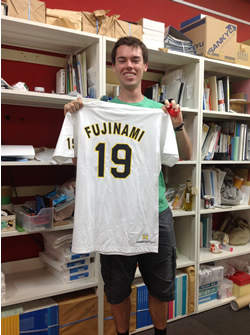
I went to a local sushi restaurant and won t-shirt from a little game they had there! I have a new favorite baseball player haha! This player is actually a half year younger than me and already famous here in Osaka. I'm hoping he'll become famous and this shirt will become even more priceless.
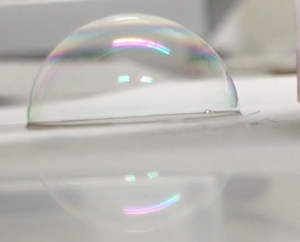
I spent more time than I care to admit trying to capture video of bubbles. Here we have a CNT bubble being printed onto a glass substrate. After the bubble pops from this position, we analyze it under the Raman Microscope. I also learned how to explain my research entirely in Japanese recently: 安く簡単にナノチューブを並べるために泡をつかいました。
グラスで泡を押しつぶしてラマン顕微鏡でグラスをみました。 データから泡でナノチューブが並んだ、ということが分かりました。
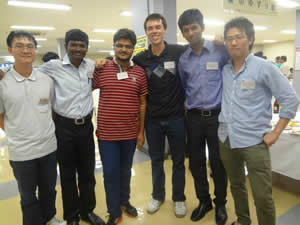
Ended the summer with the Asia Student Photonics Conference. It was an amazing experience to meet people from all across Asia! For many, I was the first American they had ever met so it was an honor to represent my country (hopefully in a peaceful and respectful way).
One of my most changed perceptions of Japanese society is the presence of religion. Before this program I believed that because of the Westernization of Japan since the landing of Admiral Perry, Christianity would have a greater presence in the nation. However, I was surprised to hear that only about 1% of Japanese people are practicing Christians. Having come from a state that is predominantly Christian, it was interesting to feel like a minority with respect to religious practices. At one point when my lab discovered my religious background, they were curious to find out that I pray on occasion. "So you're like... a serious Christian?" This was a strange question to me especially since I don't see myself as a radical evangel like some of my friends. I'm a much more "relaxed" Christian in my opinion who sees being at peace with life and God to be more important. So to be labeled a "serious Christian" even after explaining my views was strange. Seeing Japan's religious state as more of a mixture of 3 different religions is important for understanding their entire culture of group togetherness, litter culture, hospitality, humble passiveness, and lack of crime.
Upon coming back to the US the feeling of not being safe will certainly be on my mind. During my stay in Japan, even dark alleys rarely seemed scary due to the fact that so few "scary" people live here and crime is so rare. However, coming back home will not promise the same security. During the past decade of my life or so, I have wondered why parts of the world go about living where they do even though threats exist in their country such as wars, terrorist attacks, fear of government, and theft. After living in Japan, however, I wonder why Americans continue to live in places where such fearful outcomes exist. Seeing the issues of gun culture, theft, war, sickness, obesity and environmental abuse through a Japanese perspective has made me rethink the entire concept of "normal" that I once felt. Although I asked so many questions to Japanese people this summer, I feel as though I'll bring back even more questions to my American friends, family, and myself upon my return. Why do we choose to live in a place where people kill each other everyday? At any moment at night you could have everything stolen out of your possession. Is this just an accepted part of life? Do we only accept this because we are "home" and because it is "normal?" What defines "home" and how can we change it? How can we change "normal?"
I feel that we have much to gain by changing the perception of what is "normal" in our society. Why do we drive cars everywhere when bikes are so much cheaper and offer better health? Why is the thought of wearing a face mask while sick such a weird concept? This summer in Japan has accustomed me to feeling a bit different even more than I already did. Because of this, I feel ready to bring back the slightly strange but beneficial practices of the Japanese even though it will certainly make me stick out. Even though it may simply be wearing a sick mask to school when I'm not feeling well, I feel as though I've been given the opportunity and the power to try to change American culture for the better. Another significant difference that I feel compelled to mention here is that Americans truly aren't as worldly aware as I had optimistically tricked myself into believing. I thought that since Americans come from so many different places and cultures that they would be more worldly aware when compared to such a homogenous culture as Japan. However, my experience has shown me that Americans aren't truly used to other cultures at all even though their next door neighbors may be from another country. The American culture has either made all cultures into one, or the people keep themselves in subdivisional bubbles of the diverse American cultural salad bowl. Although Americans may see people from all over the world, I feel that many people that I know are not used to being in uncomfortable cultural scenarios that would be faces at the respective foreign countries of our friends and neighbors.
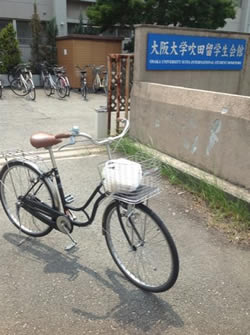
Last ride with my Japanese bike from my foreigner dorm!
The Japanese way has rubbed off on me in quite a few ways. My speech has become much more "soft." I use words like "maybe" and "perhaps" and "it would be really difficult" have entered into my lexicon. I've become much more conscious of litter anywhere and everywhere. When I go back to the States, I will attempt to set an example for not littering and picking up trash when I can as well as spreading the word to others about what's possible when an entire society has a non-littering culture. This is something we can change, one person at a time. I'll definitely be biking more for the rest of my life. This summer has shown me the value of a daily bike ride even if it is required and not just for fun. I hope to also set an example for the possibilities of a more bike friendly culture.
I can't think of many daily frustrations that I had in Japan. I feel that I'm too young and didn't stay in Japan long enough to become frustrated with many things that foreigners typically get annoyed by. However, there was one major thing that I encounter that may just be present in the Kansai region. The way people from Osaka speak is extremely difficult to understand. They often slur their words and have an unrecognizable accent with unique slang and vocal patterns. This has made learning to speak Japanese rather difficult. Without this I feel that I would be able to at least recognize more words for the purpose of looking them up. I'm not entirely sure what I've learned from this experience but it was, like most life challenges, a lesson in patience. By far the best aspect of Japanese labs is the family aspect. Although it is a bit strange that students don't commonly live on campus, it has proven beneficial to the friendliness of Japanese labs since the main social groups are usually composed of lab mates. From my experience, American labs don't share this quality since lab researchers there usually see the lab as just a place to work and not a place to live. Americans typically have diverse friends groups that don't always include lab mates. This has its own benefits for well roundedness but lacks that family aspect between lab mates and takes some of the fun away from research.
After working in a Japanese lab for the summer I've definitely had to think more about the possibility of pursuing a master's or a Ph.D. Although I feel I've made up my mind to pursue a Ph.D. after this experience, I have also been exposed to the fact that this will not be an easy experience and certainly won't be the most cost efficient. But, I feel the satisfaction that accompanies the position will make up for the lacking financial aspect of remaining a student and possibly being a professor. The international aspect of research is also an exciting part of graduate school that I've discovered so that has made the choice tempting as well. However, other factors may influence my decision in the coming years such as which graduate programs accept me.
I was lucky enough to have a going away get together at a restaurant right before my train departure on my last night at the lab. Before we left the lab to go to the restaurant I was in denial about having to leave. I was making the last touches on my poster and filing files away on my flash drive just like it was another day until I was told that it was time to go.... and we would not be coming back to the lab. At that point it hit me. I took a few pictures of the office where I had so many memories and had been accepted as part of the family. After we went to dinner and walked to the train station, I turned the corner to go to the platform and saw one last glance of my lab mates waving me off. The last glimpse caused a rush of tears as I began missing my Japanese family just as quickly as they left my field of vision. I quickly became the awkward foreigner in the subway with all of his belongings, including his pillow, sobbing in the sparsely populated train station. I hope to remain in contact with my lab friends through Facebook but it won't likely be useful for research purposes until I'm a few years older, most likely.
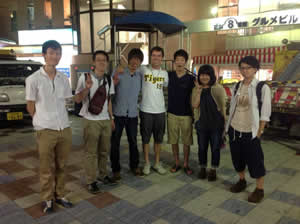
Final goodbyes with my lab. I'll miss them all so much! They made my summer better than I could possibly imagine!
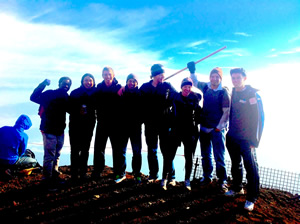
Climbed Mt. Fuji with some of my favorite nano particle scientists!

Title: Macro-scale Bubbles for Aligning Carbon Nanotubes
Host Lab: Kawata Lab of Osaka University
Host Professor: Kawata-sensei
Advising sensei: Shoji Satoru
Post Doc mentor: Kyoko Masui
Ph.D. mentor: Shota Ushiba
Because carbon nanotubes (CNTs) demonstrate highly anisotropic properties, being able to align them quickly and easily would prove to be highly beneficial for improving the speed of research and development into this field. The main objective of my research was to investigate the aligning properties of macro-scale bubbles on CNTs. Through this research we hope to find a consistent, cheap, simple, and fast method for highly aligning CNTs.
By synthesizing bubbles using plastic pipettes and a mixture of SWCNTs, surfactant, and water, we were able to make bubbles for this research. Due to the instability of the bubbles, for the purpose of analysis under Raman microscopy, a glass substrate transfer method was used to take a permanent imprint of the SWCNT behavior in the bubble structure at a particular point in time. To achieve a successful substrate transfer, one must press the glass against a living bubble and hold it as deeply against the bubble until it pops. Polarized Raman Spectroscopy was then used to analyze the alignment orientation of CNTs on the glass substrate. Raman spectroscopy is based on the theory that when CNTs are illuminated with a laser, the photons boost the electrons of the carbon atoms into a higher virtual energy state and then immediately drop down to a lower energy level. During this dropping process, light is scattered back out from the carbon atom. However, due to vibrational signatures of different molecules, this photon is released at a different frequency than the incident photon. This "Raman shift" is then used to detect the unique G-band that occurs only from CNTs. When CNTs are parallel to the polarization of light, this G-band is higher when compared to when CNTs are perpendicular to the polarization of light so we are able to use polarization dependence to determine the intensity and direction of alignment of CNTs on the glass substrate surface.
The results showed that in the walls of the bubble, radial alignment is exhibited and in the boundary of the bubble, azimuthal alignment of CNTs is shown. This is likely due to water molecule runoff running into the CNTs and aligning them with the downward path of the molecules. Also, surface tension in the coffee ring boundary is likely the reason for azimuthal alignment.
In this research we also spun the bubble at about 500 rpms to determine if this affects the alignment of CNTs in the bubble structure. We found that in the coffee ring boundary, radial alignment existed which was entirely opposite to the coffee ring result for unspun bubbles.
From this research we can conclude that bubbles may be a viable means for efficiently aligning CNTs.
Future research will include experiments that manipulate the popping dynamics of the bubble. Also different types of bubbles structures will be tested for other kinds of alignments. Attempts will also be made to achieve the highest alignments as well.